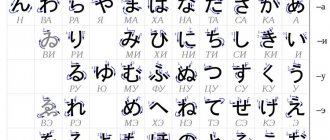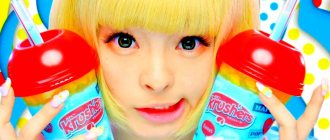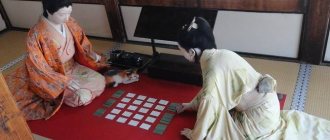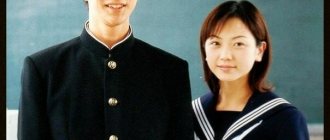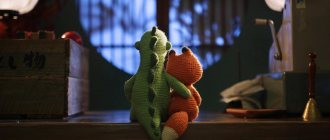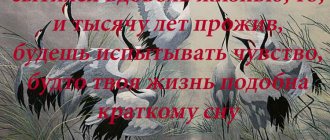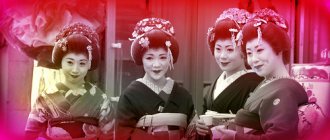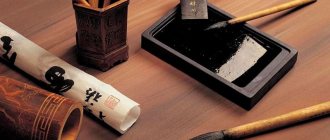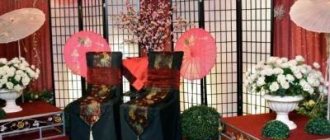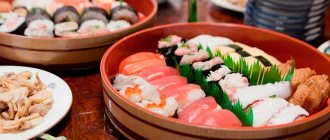Greetings, Friends. Igor Korotkov is with you. You are on the website Venasera.ru. Today we will talk about Japanese writing .
Traditionally, the Japanese language uses a vertical way of writing, i.e. The characters go from top to bottom and the columns go from right to left. This method continues to be widely used in fiction, as well as in newspapers. But in everyday life they usually use the standard, familiar to us, European way of writing , i.e. from left to right from top to bottom.
Writing in the Japanese language is divided into 2 Japanese syllabic alphabet Hiragana and Katakana , as well as kanji (hieroglyphs) .
ひらがな
Hiragana is used to write inflected parts of words, grammatical particles, or words whose hieroglyphic spelling has fallen out of use.
Hiragana characters are characterized by rounded, soft writing. Hiragana (平仮名) is translated from Japanese as “smooth alphabet” - that is, not “angular” like Katakana (片仮名). Hiragana was used by female authors of diaries and novels in the 9th to 12th centuries. Japanese poetry was written with it. Hiragana was a kind of “lightweight” letter, since it was believed that hieroglyphs for women were very difficult.
about how to easily and quickly remember the Hiragana alphabet in this video.
Hiragana table
The English language consists of vowels and consonants. Hiragana is structured a little differently, in which characters are grouped in table form depending on the sounds they represent.
This table is called Gojuon, which literally translates as “table of 50 sounds.” Each row has the same first consonant, and the columns contain the same vowel sounds.
The first row of this table contains vowel sounds: あ (a), い (i), う (u), え (e), お (o). These vowel sounds determine the order of the letters in all subsequent rows, grouped according to their consonant and vowel sounds: each row always contains the same consonant, and the columns always have the same vowel sound. This makes five letters in a row (except for the rows starting with Y and W).
Hiragana Table: Gojuon
| A | I | U | E | O | |
| K | か | き | く | け | こ |
| S | さ | し | す | せ | そ |
| T | た | ち | つ | て | と |
| N | な | に | ぬ | ね | の |
| H | は | ひ | ふ | へ | ほ |
| M | ま | み | む | め | も |
| Y | や | ゆ | よ | ||
| R | ら | り | る | れ | ろ |
| W | わ | を | |||
| *N | *ん |
*The ん, or 'N' sound does not have a vowel associated with it. It is pronounced in the same way as the English 'N.'
*The sound ん or 'N' does not have a paired vowel. He pronounces it the same way as the English 'N'. Now that we've got the table structure down, it's time to move on to pronunciation!
カタカナ
Another alphabet is katakana , used to write borrowed words from foreign languages. Those. Your name will also be written using the Katakana , because... it's foreign. Also, sometimes katakana is used to write the names of animals, plants, and also as a stylistic device to highlight the desired word.
Literally, Katakana (片仮名) is translated from Japanese as “angular alphabet.” Katakana characters are angular and sharp, in contrast to hiragana characters, which differ significantly in their smoothness. Compare! This is Hiragana and this is Katakana.
We talked about how to easily and quickly remember the Katakana alphabet in this video.
Katakana was invented by monks to rewrite Chinese texts, in particular Buddhist sutras, and just like Hiragana, it originated from Chinese characters, but not from whole characters (as was the case in Hiragana ), but from their parts. Unlike hieroglyphs the Hiragana and Katakana syllabaries convey only sound, without any meaning.
In order not to waste your time, we will not dwell in more detail on the origin of Japanese writing , but will move on to examples.
Hiragana
First, let's look at hiragana, which is the foundation of learning the Japanese language. If you forget how to pronounce a word, you will most likely be able to find its pronunciation in Hiragana. On Kanjiway we use romaji for hiragana and katakana, so in this article we will use the Latin alphabet for hiragana.
Let's jump straight to the examples:
- あさ - asa (morning)
- つき - tsuki (moon)
- いま - ima (now)
- ねこ - neko (cat)
- ありがとう - arigatou (thank you)
- さようなら - sayounara (see you later)
We also recommend that you watch this video to understand how to pronounce hiragana.
Hiragana consists of 46 characters, plus their derivatives, which ultimately give us 71 characters. Here
. You can even print it out.
Dakuten (or Nigori)
The dakuten sign looks like two dashes in the upper right corner. It is written above some kans and changes the sound of the consonant letter in the syllable. Imagine voiced and voiceless consonants in the Russian language and you will immediately understand what we are talking about.
- た (ta) -> だ (da)
- か (ka) -> が (ga)
- さ (sa) -> ざ (za)
- は (ha) -> ば (ba)
Handakuten (or Hannigori)
Handakuten is almost the same as dakuten, but is used for two letters: "h" and "f", which become "p" (English "p"). Looks like a circle in the upper right corner.
- は (ha) -> ぱ (pa)
- ひ (hi) -> ぴ (pi)
- ふ (fu) -> ぷ (pu)
- へ (he) -> ぺ (pe)
- ほ (ho) -> ぽ (po)
Small letters
There are 4 letters in hiragana that can be written in either regular or small font: つ (tsu), や (ya), ゆ (yu), よ (yo). When written in regular font, they are read exactly as we have written them down, but when written in small font, their meaning changes. Compare how they look when written side by side: つっ やゃ ゆゅ よょ
ゃ, ゅ, ょ - with these symbols everything is simple, they “soften” the syllable that comes before them and replace it with their own:
- きや (kiya) -> きゃ (kya)
- にゆ (niyu) -> にゅ (nyu)
- りよ (riyo) -> りょ (ryo)
The small tsu is a special character that does not have its own reading, but doubles the consonant that comes after it:
- したい (shitai) -> しったい (shittai)
- がこ (gako) -> がっこ (gakko)
- いた (ita) -> いった (itta)
We understand that there is a lot of information here for you to remember on your first day. Kanjiway will help you learn and remember all hiragana well in a few days, as well as get used to reading words in hiragana. Don't worry if you read hiragana very slowly from the beginning, the key is to practice. Over time, you will read it as quickly as a text in Russian.
An example of using Japanese alphabets
Now some examples.
As we have already said, the changeable parts of a word are written in Hiragana: for example, there is a verb to look 見る (WORLD), the root of the hieroglyph (i.e. its unchangeable part) is written first -見 (MI) . It will be written in hieroglyphs. This word has a variable part - the ending る, which will change depending on the need, for example, if you need to convey the tense of the verb or the style of politeness. So 見るcan change to 見ます, 見ました, etc. Also, do not forget that grammatical particles in Japanese are also written in Hiragana , for example:私はイーゴリです。 “I am Igor.” In this case, the grammatical particle Ba and the copula Des will be written in Hiragana . My name is not Japanese, i.e. it is borrowed from the Russian language, so it is written in Katakana alphabet. I am Watashi is a Japanese word and it is written in Kanji, i.e. hieroglyph. As you may have noticed, Japanese writing consists of a combination of the Hiragana/Katakana alphabet and hieroglyphs .
Now some examples about Katakana alphabet . Japanese has quite a lot of borrowed words, such as Basu - bus, it is borrowed from English, so it is written in Katakana , the word Pan bread is borrowed from Portuguese, so it is also written in Katakana . Such words are called Gairaigo 外来語.
Now let's look at an example not related to borrowed words. The word “Cat” ( Neko) is written not only in hieroglyphs or Hiragana alphabet , but is also often written in Katakana alphabet - like this. This word is not borrowed, however, animals and plants can also be written in Katakana . And the names of plants are almost always written in katakana , because it’s not even difficult to imagine that it’s much easier to write ツツジ this way than 躑躅. In the post-war reforms, it was recommended to write in katakana , regardless of origin.
Most often, onomatopoeic words are written in Katakana, and figurative words in Hiragana, but this is not so important.
But again, everything is individual, for example, in everyday life such words as Cat, Dog or Cow can often be found in hieroglyphs, and already such words as イノシシ, タコ or ツツジ, etc. Words are most often written in katakana.
I would like to note that when I talk about using Katakana (the theme with animals), do not take everything literally, because... there are a lot of nuances, for example, the type of animal Octopus - Tako, will be written in katakana, and on the store window, as a Takoyaki dish it will be written たこ焼き or タコ焼き, but a simple Japanese will write a Takoyaki dish like this: たこ焼き.
Katakana was also used to write Japanese telegrams when they existed.
The same with general imitative (擬態語) and onomatopoeic (擬声語) words. Usually the Japanese write general imitation words in Hiragana and onomatopoeic words in Katakana, but sometimes they write differently. Don’t focus your attention on this; at the initial stage it is absolutely not important.
Also, sometimes, in various shows, they want to highlight a certain word and make a stylistic highlight of this word, which is usually written in Hiragana or a hieroglyph. For example, it is usually written like this. And they changed it like this.
If we summarize and simplify to the maximum all of the above, then, roughly speaking, Hiragana can be attributed to the function of the main alphabet, and katakana can be attributed to the recording of borrowed words.
Kanji
Kanji is a system of characters in the Japanese language. It consists of tens of thousands of characters, but we only need to learn 2136 joyo kanji. The pronunciation of each kanji can be written in both hiragana and katakana (most often in hiragana); Japanese children often use texts with furigana to learn kanji.
The undeniable advantage of kanji is that texts become much shorter. For example, what would be faster for you to write down?
- 車
- くるま (kuruma, hiragana notation for 車)
- Car
In 2021, Twitter increased the maximum number of characters in a tweet from 140 to 280, on this occasion they wrote an article where they said that a tweet in English takes on average 34 characters, and in Japanese - 15.
Very often kanji is combined with hiragana because hiragana is also used for grammatical sentence structure. For example, 食べる (to eat, read as taberu), consists of the kanji 食 (ta) and the hiragana べる (beru). If we did not want to “eat” in the current tense, but “ate” in the past tense, we would use the same kanji 食 (ta), but a different hiragana 食べた (tabeta) or 食べました (tabemashita).
Most people here have a logical question - “And if all kanji can be written in hiragana and katakana, then maybe they don’t need to be learned?” The problem is that the Japanese write without spaces . Spaces are used only in conjunction with punctuation marks. They distinguish between words and parts of sentences precisely through the constant alternation of hiragana, katakana and kanji. That is, if you use only hiragana without kanji, then your Japanese will look something like this. As you can see, this is not very convenient. If you use Kanji, it will be more like writing. Maybe for us it still looks strange, but the Japanese are already used to it, there’s nothing very complicated about it. In Japan, only small children write in hiragana without kanji, so if you decide to do the same, you will be thought of as a small child.
Originally, the Japanese language did not have its own elaborate writing system, so the Japanese borrowed a writing system from China. In fact, kanji are Chinese characters, although some of them have changed slightly over time. As a result, it turned out that the Japanese had their own language and a foreign writing system, which had to be somehow made friends with each other. This has led to the fact that most kanji now have two types of reading (or pronunciation) - the original Chinese (on'yomi) and the Japanese (kun'yomi). Depending on the context in which you read the kanji, you will either read it using the original Chinese pronunciation or the Japanese pronunciation. This may seem confusing, but again, there is nothing terribly complicated about it. Imagine the Russian word for "castle". You might say, “After the battle, the knight returned to the castle,” or “I put a lock on my garage.” For us, there is no confusion here and over time you learn Japanese, you will also get used to the different readings of kanji.
漢字
The next video will be about hieroglyphs, but in short, hieroglyphs or Kanji (as they are called in Japan) were borrowed from China in ancient centuries and the Japanese used them for their own needs. Before kanji, Japan did not have its own writing system, because... the same invented alphabet Hiragana and Katakana are derivatives of hieroglyphs .
Hieroglyphs , as a rule, have at least 2 readings: on'yomi (the so-called Chinese reading) and kun'yomi (the so-called Japanese reading). We will talk in more detail about which readings and when to use in the next video.
That's all for today. If you liked the video, like it, tell your friends, subscribe to the channel, and also to our groups on social media. Networks, Igor Korotkov was with you. See you in the next video!
Small hiragana and sound combinations
There are many cases where small hiragana characters are used in combination with regular characters to produce sounds that are not in the main table.
Yun (pronounced yo-on) is a combination of sounds that uses a regular hiragana character followed by a small 'ya,' 'yu' or 'yo'. When such a small character is encountered, it cancels the vowel sound of the preceding Hiragana character, thus connecting only the consonant sound to the following small character.
For example, 'kya' is written as きゃ, a combination of the regular character き (ki) and the small character や (ya). Although it is written as 'ki' + 'ya', the two sounds combined become 'kya.'
Other examples of yuns: ぎゃ – gya – ぎ+や – gi + small ya = gya じゃ – ja – じ+や – ji + small ya = jya or 'ja'
Note that in these cases, the first major hiragana character is usually the 'i' form of the letter (ki, gi, ji) as above.
Small 'tsu'つ (Sokuon) Sokuon is a stop between two Syllables. This usually places emphasis on the syllable that comes before つ.
